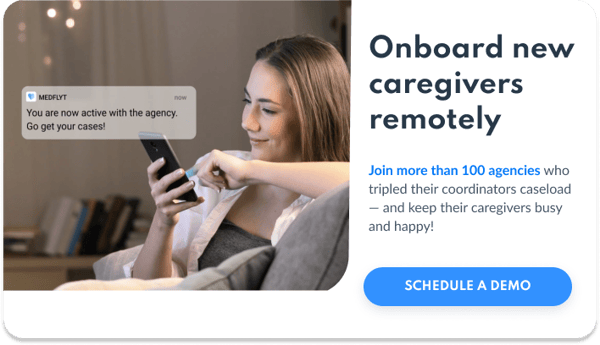How COVID-19 Changed Home Care Orientations for the Better

Has the pandemic created an environment for a more streamlined approach to orientation? Maybe.
COVID-19 has changed the home care industry in multiple ways. At the beginning of the pandemic, due to social distance rules, home care agencies were scrambling to find a way to successfully onboard new team members without meeting face-to-face. However, agencies were quickly discovering that online orientation was actually more effective than the traditional face-to-face model.
Today, home care providers all across America are making online orientation the standard in their new hire protocol. The outcomes are better with an online approach: caregivers are able to learn in their preferred language, and on their own time with their smartphones. Plus, caregivers receive the same information as their co-workers, creating a cohesive team experience. Finally, an online orientation approach ensures that Human Resources managers, as well as nurse and caregiver educators, are spending their time with patients and not managing a busy, in-person orientation schedule.
Could home care online orientation be a positive outcome of the pandemic? We think so, and here’s why.
Creating Effective Orientation Programs
A home care agency’s orientation program is two-fold. It is both crucial to increasing patient care quality and to decreasing staff turnover. Unfortunately, most home care agencies cannot figure out how to create an orientation program that is effective and timeless enough to last for years while still engaging new hires with good content.
When developing a caregiver orientation program, here are a few considerations to keep in mind:
Does a staff member have to teach the orientation materials in-person to the new hire?
Unfortunately, this traditional model of orientation training is simply not feasible in today’s fast-paced home care world. Find a way to make orientation accessible to new hires without taking valuable time away from your Human Resources team.
Is there a way to quickly change orientation information as policies or regulations change?
Home care orientations must be flexible, or information becomes quickly outdated. Find a way to create content that can be easily changed or adapted when policies or regulations are updated.
Is there a way to ensure caregivers are staying engaged and paying attention throughout the orientation process?
Adult learners are notoriously difficult to engage, and while your orientation might offer an assessment at the end of the program, most agencies do not have a way to actively engage caregivers throughout the program.
Is there a way to teach caregivers information in their preferred language?
Many adult learners retain information better when it is taught in their preferred language, even if they are fluent in English. Can you find a way to create an orientation program that can be effectively translated into the preferred language of your new hires?
Solutions Available
Developing agency-specific orientation that will last and will increase the quality of care for all patients sounds like an overwhelming task, and it can be. However, there are some solutions that home care agency owners can use as they create their ideal orientation.
Pre-made orientation templates
Typically available for download, these templates give agencies the outline for a solid home care agency orientation. The agencies simply input their current policies and procedures in order to personalize the information. Then, home care agencies can print out orientation handbooks and review those with new hires.
While this is an excellent solution, pre-made templates come with a few drawbacks. Team members still need to review the information with new hires either in-person or on the phone, which is time-consuming for everyone. The templates are also typically in English only and are not comprehensive, which means agencies still need to spend a lot of time building their information into the template.
Mentor programs
Some agencies choose to set up new hires with an experienced caregiver Mentor. This is an excellent solution as it offers new hires a relationship with an experienced Mentor as well as hands-on training before taking on a patient alone. Drawbacks for this method include high caregiver turnover which can overload a Mentor’s caseload.
Virtual welcomes
With COVID-19 making in-person meetings less common, companies across the marketplace are working on developing ways to make new hires feel welcome and a part of a team. These virtual welcomes can include video calls or even online orientations, though it can be difficult for caregivers to find a time to squeeze in a structured call, especially if they work overnight.
The Mobile Answer to Effective Orientation
At Medflyt, we have dedicated ourselves to creating systems that make home care functions as easy as possible, for everyone involved. Our new comprehensive online orientation program allows agencies to provide the information caregivers need to know in an engaging way, right on their smartphone.
New hires benefit from Medflyt’s orientation program by:
- Content is available in 12 languages, allowing them to learn in the language they prefer.
- Reliable and realistic information that they can apply to their caregiver job immediately.
- Engaging vertical orientation videos, right on their smartphone, making it much more engaging, convenient, and easier to use.
- Real-time answers to any questions via a messaging system to a Medflyt professional.
- Immediate assessments and completion certificates.
Home care agencies also benefit from Medflyt’s orientation:
- Training is comprehensive, engaging, and educational.
- Quickly personalize information now and change it easily later if needed. All content is easily adapted to agency needs and specifications, from dress code to attendance policy to emergency contact information.
- Watch new hire progress in real-time
- Modules are designed for the mobile experience, increasing caregiver interest, and engagement which can increase staff participation
Home care orientation should be informative and stimulating for new hires, and it shouldn’t be time-consuming to set up and get going. Medflyt’s orientation provides a solution that works for agencies and for new hires, creating a sustainable way to welcome new caregivers to your team.
Schedule your demonstration today.
Subscribe to updates!



